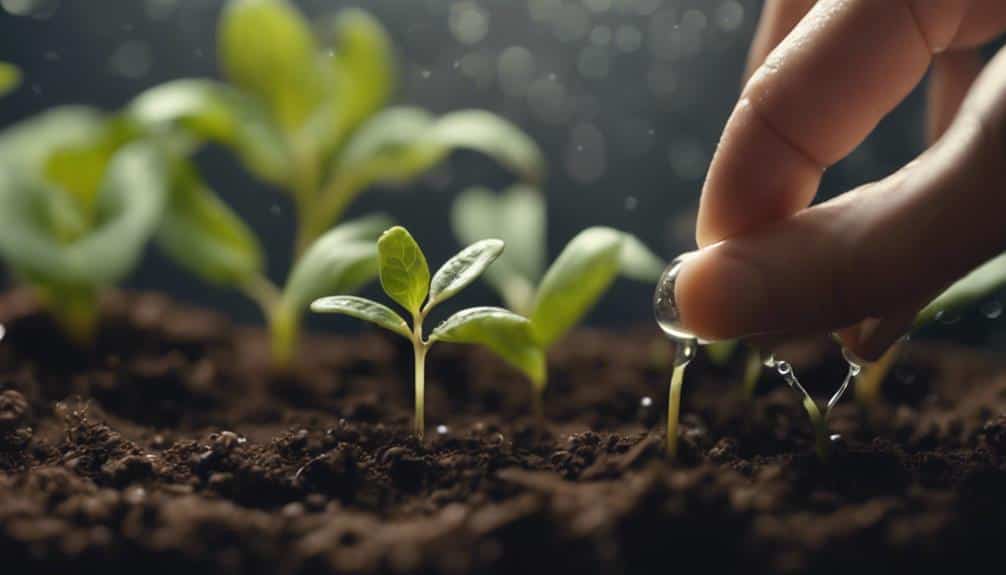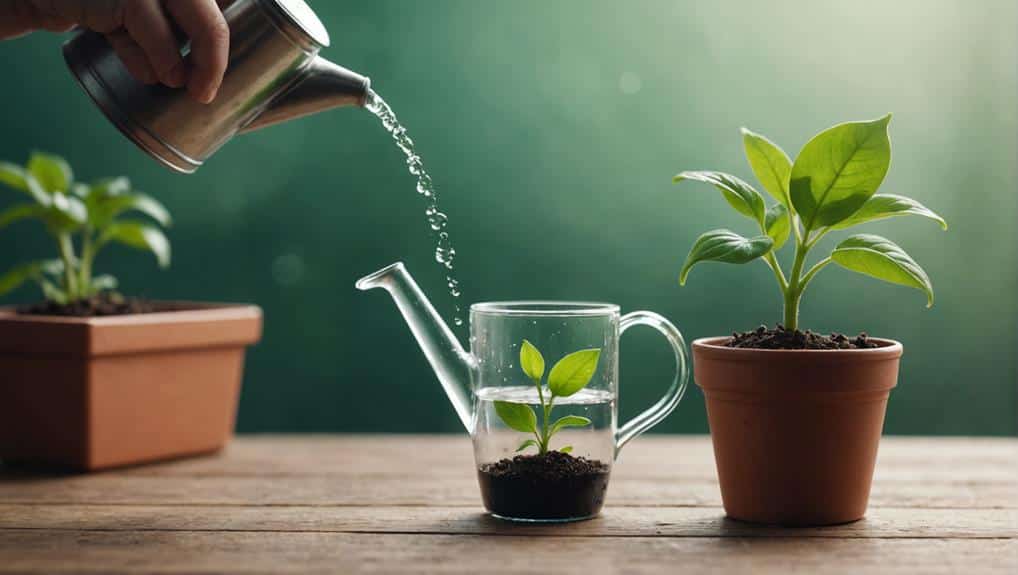How Often To Water Seedlings
To keep your seedlings happy, water them when the top inch of soil is dry. Roots need consistent moisture to grow well and avoid diseases.
Check the soil every day and water only if it's dry. Don't overwater, as it can cause root rot.
The right watering frequency depends on pot size, soil type, and surroundings. By understanding these factors and keeping an eye on soil moisture, you can create a watering plan that helps your seedlings thrive.
TLDR
- Water your seedlings every day to keep the soil consistently damp, but be careful not to water them too much, as this can cause diseases and root rot.
- Adjust how often you water based on factors like the size of the pot, the type of soil, the temperature, and how old the seedlings are to help them grow well.
- Check the soil regularly to make sure it's damp but not waterlogged, and water accordingly.
- Water the seedlings from the bottom to avoid getting the leaves wet, and use soil that drains well to help the roots grow.
- Create a watering schedule that fits the way you're growing your seedlings, whether it's in peat pellets, pots, or soil blocks.
Understanding Seedling Watering Needs

To help your seedlings grow well, it's important to know how much water they need. Seedlings need a good amount of moisture to grow strong roots. You should water them every day to keep the soil consistently damp.
Be careful not to water too much, as this can cause a common disease in seed trays. If the soil is too dry, the seeds may not sprout. Keep an eye on the soil to make sure it's not too wet or too dry.
Factors Affecting Watering Frequency
Many things decide how often you should water your seedlings. These include the size and material of their pots, the kind of soil used, and how old the seedlings are.
Small pots may need more water than larger ones. If the soil is peat-based or coco coir, it might need watering every day because they hold a lot of moisture.
Warmer rooms make seedlings thirstier and need more water. By thinking about these things, you can figure out how often to water your seedlings to help them grow well.
Importance of Soil Moisture Checks

You have an important job to make sure your seedlings get the right amount of water. Check the soil often to keep them healthy as they grow.
If the soil is too wet, it can cause problems like root rot and diseases that slow down seedling growth. Each type of soil mix needs a specific amount of moisture, so adjust how often you water accordingly.
The soil should be consistently damp but not soaked to help your seedlings grow well. Keep an eye on the moisture and adjust your watering routine to give your seedlings the best chance to thrive.
Effective Watering Techniques for Seedlings
Now that you know how to check if the soil is moist enough, let's talk about the best ways to water your seedlings.
To keep your seedlings healthy, water them from the bottom to avoid getting their leaves wet, which can cause damping-off disease. If you have seedlings in trays indoors, water them from below so the top soil stays damp.
Check the soil every day to see if it needs more water and adjust your watering routine as needed. Using soil that drains well is important to prevent water from pooling and help the roots grow strong.
Following these tips will help your seedlings grow into healthy plants.
Watering Guidelines for Different Methods

Now that you know how to water plants effectively, it's time to adjust your watering technique based on the method you're using. Whether you're using peat pellets, pots, or soil blocks, each method has its own watering rules to help your plants grow well.
Watering Guidelines for Peat
When using peat pellets, it's important to know how much water they need for healthy seedling growth. Before planting seeds, soak the peat pellets in warm water until they expand fully.
After planting, keep the growing medium slightly moist for the best results. Water the peat pellets from the top two to three times a week to keep them hydrated. Be careful not to water them too much, as this can harm the seedlings.
Peat pellets are easy for starting seeds, but it's crucial to watch the moisture levels closely to avoid problems. By following these tips, you can create a good environment for your seedlings to grow well.
Watering Guidelines for Pots
To water your potted seedlings properly, adjust how often you water based on plant size and room temperature. Start fast-growing plants in 4-inch pots, watering them once or twice a week. As the seedlings grow, change the watering schedule as needed.
You can water from the top or bottom of the pots. For biodegradable containers, keep the soil slightly moist by watering three to four times a week. It's crucial to keep the moisture level consistent, especially with peat pellets or other growing materials.
Watering Guidelines for Blocks
When you switch from pots to blocks, change how you water your plants. Soil blocks are delicate, so be gentle to prevent them from falling apart.
Start by misting them with your hand, then switch to bottom watering to keep them stable. Once your seedlings grow real leaves, water them two to three times a week for the best growth.
It's important to keep the soil blocks moist consistently to help the roots grow well. Bottom watering helps spread the water evenly and prevents overdoing it.
Following these steps will give your seedlings the right amount of water to thrive in their soil blocks.
Mastering Seedling Watering Schedules
Creating a watering plan for your seedlings is super important. You have to pay close attention and be ready to change things up.
Water your seedlings once a day to keep the soil moist but not too wet. Adjust how often you water as your seedlings get bigger.
Try bottom watering or drip irrigation to avoid overwatering and help their roots grow strong. Keep an eye on how you water and be ready to make changes.
Once you figure out the best watering schedule for your seedlings, they'll grow healthy and strong.
Common Mistakes to Avoid

Taking care of your seedlings requires avoiding common mistakes that can harm their growth or even cause them to die.
Make sure not to water them too much, as this can lead to damping-off disease. Also, be careful not to water them too little, as this can cause wilting and slow growth.
Being mindful of these issues will help you provide the right amount of water to your seedlings at the right times.
Overwatering Seedlings
Overwatering seedlings is a common mistake that can harm them. It can cause root rot, fungal diseases, and slow growth. Look out for signs like yellow leaves, wilting, and mold on the soil.
When growing seedlings in pots, make sure there are holes for water to drain out. Too much water reduces oxygen in the soil, which stops roots from growing well. To avoid overwatering, let the top of the soil dry a bit before watering again.
This simple step can protect your seedlings from problems like root rot and fungal diseases. By watching out for these issues, you can make sure your seedlings get the right amount of water to grow well.
Insufficient Watering Seedlings
If you forget to water your seedlings enough, they won't grow well. Dry soil can make them small and weak because they can't get the water and food they need.
This also makes them more likely to get sick from bugs and diseases. Without water, seedlings can't grow good roots, which are important for strong plants.
Don't let your seedlings suffer from not enough water. Keep the soil moist so they can grow strong and healthy. This way, your seedlings will have a better chance to thrive and do well.
Conclusion
You now know the key things for watering seedlings, like understanding what they need and using the right watering methods.
By avoiding common mistakes and following specific guidelines, you can provide the perfect amount of water for your seedlings.
Keep an eye on the soil moisture and adjust your watering schedule as necessary.
With practice and patience, you'll figure out a routine that helps your seedlings grow well.







